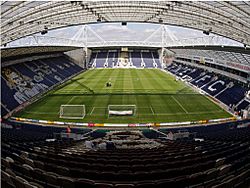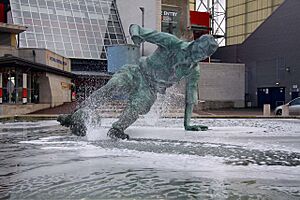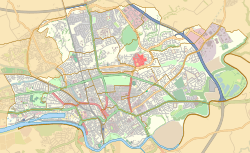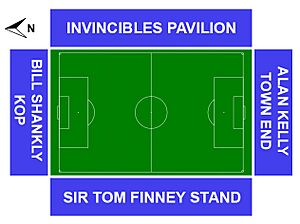Deepdale facts for kids

Interior of the stadium
|
|
| Full name | Deepdale Stadium |
|---|---|
| Location | Sir Tom Finney Way, Preston, Lancashire, PR1 6RU, England |
| Coordinates | 53°46′20″N 2°41′17″W / 53.77222°N 2.68806°W |
| Owner | Preston North End F.C. |
| Operator | Preston North End F.C. |
| Capacity | 23,404 |
| Field size | 110 by 77 yards (101 m × 70 m) |
| Construction | |
| Built | 1875 |
| Opened | 1878 (for PNE) |
| Renovated | 1995, 1998, 2001 |
| Tenants | |
| Preston North End F.C. (1878–present) Lancashire Lynx (1996–2000) |
|
Deepdale is a famous football stadium located in Preston, England. It is the home ground for the football team Preston North End. Deepdale was built in 1875 and has been used for football since 1878. It is known as one of the oldest football stadiums in the world that has been used continuously.
Contents
Deepdale's Story
The land where Deepdale Stadium now stands was once a farm. A local sports club, North End, leased the land in 1875. At first, it was used for sports like cricket and rugby. The very first association football match was played there on October 5, 1878. Later, in 1890, the first professional baseball game also took place at Deepdale.
Early Days of Deepdale
As football became more popular, more space was needed for fans. This led to the creation of raised areas for spectators, known as terraces. In the 1890s, Preston built the West Paddock along the side of the pitch. A tent was even used as a changing room for players.
By the early 1900s, over 10,000 people regularly came to watch games. So, the stadium needed to grow again. The Spion Kop terrace was built, and the West Paddock was made longer. The Town End stand was finished in 1928, but a fire destroyed it five years later. It had to be rebuilt. A smaller stand, the Pavilion Stand, was opened in 1934. It held changing rooms and offices.
The most people ever to watch a league game at Deepdale was 42,684. This was for a match against Arsenal in 1938. A famous women's team, Dick, Kerr Ladies, also played at Deepdale. They often attracted huge crowds of thousands of fans.
A Protest at Deepdale
In 1913, there was an attempt to damage the Deepdale ground. This was part of a wider protest by women who wanted the right to vote. These women, called suffragettes, sometimes targeted places like sports grounds. They did this to show how serious they were about their cause. Other football stadiums were also targeted during this time.
The Plastic Pitch Era
In 1986, Preston North End tried something new. They installed an all-weather plastic pitch. The idea was to earn extra money by renting it out to local teams. It also meant fewer games would be cancelled because of bad weather. Deepdale was one of only four stadiums in the English league with a plastic pitch. However, fans did not like it very much. By 1994, it was the last plastic pitch left in the league and was finally removed.
Modern Deepdale Renovation
Deepdale Stadium has been completely rebuilt over the years. The new design was inspired by a stadium in Genoa, Italy. The big changes started in 1995. The old West Stand was taken down and replaced with the new Sir Tom Finney Stand. This stand cost £4.4 million and includes areas for the press and restaurants.
Next, the Bill Shankly Kop was built in 1998. Then came the Alan Kelly Town End in 2001. In 2008, a large 25-meter screen was added to the roof of the Bill Shankly Kop.
The old Pavilion stand was replaced by 'Invincibles Pavilion' for the 2008–09 season. This name honors the Preston North End team from 1888–89. They were the first League champions and the first team to win both the League and FA Cup. They are also the only English team to complete a season unbeaten in both competitions. The Invincibles Pavilion has special executive boxes and a restaurant overlooking the pitch. It also houses the stadium's control rooms and an NHS walk-in health center.
Today, Deepdale is an all-seater stadium. This means every fan has a seat. Its total capacity is 23,404 people.
- Sir Tom Finney Stand: 7,893 seats
- Bill Shankly Kop: 5,933 seats
- Alan Kelly Town End: 5,859 seats
- Invincibles Pavilion: 3,719 seats
Sir Tom Finney Statue

Outside the Sir Tom Finney Stand, you can see a statue of the famous player, Sir Tom Finney. A sculptor from Preston, Peter Hodgkinson, created it. The statue was made for Finney's 80th birthday and revealed in July 2004.
It was inspired by a famous photo from a game in 1956. Sir Tom Finney himself explained:
The game was in 1956. There had been a big downpour just before the kick off. The match would not have been played today because there were huge pools of water on the playing surface. I was going past a defender and the ball ran in to a pool of water. It was a fantastic photograph and it won the Sports Photograph of the Year award. The sculpture is a true likeness.
International Games at Deepdale
Deepdale has hosted more than just club matches. In 2005, it was used for three group games and a semi-final during the 2005 UEFA Women's Championship. It also hosted an England Under-21s game against Iceland in March 2011. Two England Under-19s matches were played there in the 2011–12 season.
The National Football Museum
From 2001 to 2010, the National Football Museum was located in the Bill Shankly Kop stand at Deepdale. This museum project started in 1995. It received funding from a National Lottery Heritage grant. The museum displayed amazing items, like the match ball from the 1966 World Cup Final. It also had a cap from the world's first ever football international match in 1872. About 100,000 visitors came to the museum each year. In 2010, the museum moved to Urbis in Manchester.
See also
 In Spanish: Deepdale para niños
In Spanish: Deepdale para niños
- List of stadiums in the United Kingdom by capacity
- Lists of stadiums



